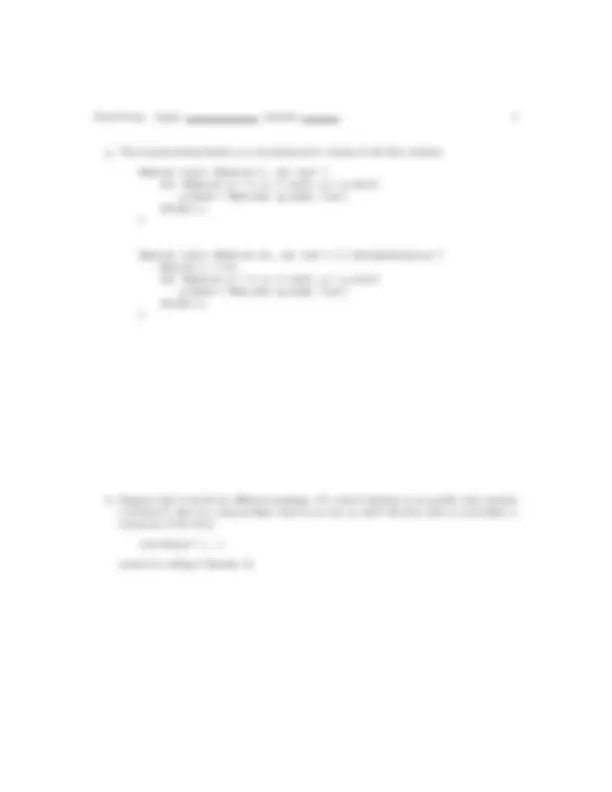












Study with the several resources on Docsity

Earn points by helping other students or get them with a premium plan


Prepare for your exams
Study with the several resources on Docsity

Earn points to download
Earn points by helping other students or get them with a premium plan
Community
Ask the community for help and clear up your study doubts
Discover the best universities in your country according to Docsity users
Free resources
Download our free guides on studying techniques, anxiety management strategies, and thesis advice from Docsity tutors
A final exam for a java programming and data structures course, including multiple choice questions, code analysis, and problem-solving tasks. It covers topics such as functions, classes, packages, shortest path length algorithm, hash sets, and trie data structure.
Typology: Exams
1 / 18

This page cannot be seen from the preview
Don't miss anything!











CS61B, Fall 2007 Final Examination P. N. Hilfinger
READ THIS PAGE FIRST. Please do not discuss this exam with people who haven’t taken it. Your exam should contain 7 problems on 18 pages. Officially, it is worth 50 points. This is an open-book test. You have three hours to complete it. You may consult any books, notes, or other inanimate objects available to you. You may use any program text supplied in lectures, problem sets, or solutions. Please write your answers in the spaces provided in the test. Make sure to put your name, login, and lab section in the space provided below. Put your login and initials clearly on each page of this test and on any additional sheets of paper you use for your answers. Be warned: my tests are known to cause panic. Fortunately, this reputation is entirely unjus- tified. Just read all the questions carefully to begin with, and first try to answer those parts about which you feel most confident. Do not be alarmed if some of the answers are obvious. Should you feel an attack of anxiety coming on, feel free to jump up and run around the building once or twice.
Your name: Login:
Login of person to your Left: Right:
Discussion section number or time:
Discussion TA:
Lab section number or time:
Lab TA:
a. If a function that executes the following fragment returns a negative int value, then x must have been larger than 15.
x = g (y) >>> 1; return x << 27;
b. Because of its catch clauses, the program fragment below can go into an infinite loop if readData throws IOExceptions.
try { result = null; result = readData (0); } catch (IOException e) { reportProblem (result.message); } catch (NullPointerException e) { /* Try alternate channel. */ result = readData (1); }
c. If the following code fragment prints “<0” then x must be an instance variable or a static (class) variable.
x = 1; f (x); if (x < 0) System.err.println ("<0");
g. The second method below is a non-destructive version of the first method.
GenList limit (GenList L, int lim) { for (GenList p = L; p != null; p = p.tail) p.head = Math.max (p.head, lim); return L; }
GenList limit (GenList L0, int lim) { // Non-destructive? GenList L = L0; for (GenList p = L; p != null; p = p.tail) p.head = Math.max (p.head, lim); return L; }
h. Suppose that P and Q are different packages. If a class P.Secret is not public and contains a method F, then in a class Q.User, there is no way to call F directly (that is, in Q.User, a statement of the form
something.F (...)
cannot be calling P.Secret.F).
a. For the definition of shortestPathLength below, demonstrate that the worst-case time for computing shortestPathLength(1,2) is Ω(2N^ ). (Hints: this is a loose bound; you can consider just part of the execution of SPL to get it. The time required to compute SPL depends only on k, whose initial value comes from shortestPathLength.)
/** The length of the shortest path between vertex V0 and vertex V1. */ int shortestPathLength (int v0, int v1) { return SPL (v0, v1, N); }
/** The length of the shortest path between vertex V0 and V1 that uses
Problem continues on the next page.
class StringHolder { private String val;
StringHolder (String initial) { val = initial; }
public boolean equals (Object x) { return val.equals (x); } public int hashCode () { return val.hashCode (); }
void put (String val) { this.val = val; } String get () { return val; } }
If we create some of these and insert them into a HashSet like this:
HashSet
where A is an array of Strings, then S.contains(builders[i]) will be true for 0 ≤ i < N.
a. Explain why S.contains(builders[i]) may no longer be true after executing
for (int i = 0; i < N; i += 1) { builders[i].put (B[i]); }
even though S will still contain each of the objects builders[i].
Continued on next page
Now let’s fix the problem raised in part (a) by defining a new kind of HashSet that requires its elements to implement an interface Observable. We’ll call this new type HashMutableSet. The idea is that Observable objects define a method that allows another object (in our case, a HashMutableSet) to “register” itself as an observer of the Observable object. At any given time, an Observable may be observed by any number of objects (e.g., a StringHolder might belong to any number of HashMutableSets simultaneously). To function as an observer, a class (in our case, HashMutableSet) must implement another interface, which we’ll call Observer. An Observer provides two methods by which an Observable object that it has registered with can inform the Observer of changes to that Observable object. The Observable object calls one method on all of its Observers just before it makes some change to itself, and it calls the other method just after it makes some change to itself. For both methods, the Observable passes itself (the object that is changing) as an argument. So the idea is that when a HashMutableSet .adds an object, A, to itself, it first registers itself to observe A. If a method of A wants to change A’s value, then it first tells all of A’s registered observers (including our HashMutableSet) that A is about to change, and after carrying out the change, it tells the same observers that A’s value has changed. The rest of this problem involves implementing this idea.
b. Define the interfaces Observable and Observer. These interfaces must not be specific in any way to HashMutableSet or StringHolder.
public interface Observable {
public interface Observer {
Continued on next page
d. Finally, implement HashMutableSet as an extension of HashSet. Beyond the new methods you must implement, just worry about the .add method; we won’t worry about removing ob- jects. Again, this must work with any kind of Observable, not just ObservableStringHolder.
class HashMutableSet
/** Add OBJ this THIS. Returns true iff OBJ is not already
// FILL IN AS NEEDED (our solution is 6 non-blank lines)
a. Could these be major steps from a run of quicksort? Why or why not? dze ccf bkw hwy pjk xce aux qtr xpa atm atm ccf bkw hwy pjk xce aux qtr xpa dze atm aux bkw hwy pjk xce ccf qtr xpa dze atm aux bkw ccf pjk xce hwy qtr xpa dze atm aux bkw ccf dze xce hwy qtr xpa pjk atm aux bkw ccf dze hwy xce qtr xpa pjk atm aux bkw ccf dze hwy pjk qtr xpa xce atm aux bkw ccf dze hwy pjk qtr xce xpa
b. Nunne T. Wisely wrote a program that he thought performed an LSD radix sort. Here is an illustration at major steps of the algorithm, starting with the input. As you can see it gets the wrong answer in this case. Describe as succinctly as possible how he’s apparently messed up the algorithm. dze ccf bkw cwy pjk xce dzx ctr xpa pjm xpa xce dze ccf pjk pjm ctr bkw dzx cwy ccf xce pjm pjk bkw xpa ctr cwy dzx dze bkw cwy ctr ccf dze dzx pjk pjm xpa xce
c. What sorting algorithm does the following illustrate? The first line represents the input and the remainder are contents of the output array at points in the algorithm where it changes (‘--’ means “not yet assigned to”). 14 13 10 17 23 26 07 24 29 04 -- -- -- -- 14 -- -- -- -- -- -- -- -- 13 14 -- -- -- -- -- -- -- 10 13 14 -- -- -- -- -- -- -- 10 13 14 17 -- -- -- -- -- -- 10 13 14 17 23 -- -- -- -- -- 10 13 14 17 23 -- 26 -- -- 07 10 13 14 17 23 -- 26 -- -- 07 10 13 14 17 23 24 26 -- -- 07 10 13 14 17 23 24 26 29 04 07 10 13 14 17 23 24 26 29 04 07 10 13 14 17 23 24 26 29
a. Suppose that f 1 (x), f 2 (x),... are all (possibly different) functions, each of which is in O(1). Define g(n) =
1 ≤i≤n fi(n). Show how it is possible for^ g(n) to be in Ω(N^
b. We represented the heap data structure (used for priority queues) with an array. But a heap is a form of binary tree. Why don’t we use arrays for all binary trees?
c. We can explore the nodes of a binary tree one level at a time using either breadth-first search, in which we visit each node once, or by iterative deepening, where we traverse nodes by depth-first search down to a maximum depth multiple times, increasing the maximum depth by one each time. In the best case for iterative deepening, if we visit N nodes by breadth-first search, how many nodes do we visit using iterative deepening?
More parts on the next page.
d. If we have space to store M nodes (in addition to the space already occupied by our tree), how deep a tree can we explore using breadth-first search (see problem c)?
e. Suppose we have a heap in which the top value is the largest. At what depths in the tree (distances from the root) can the fourth-largest value occur? Give examples in which it occurs at the minimal possible depth and at the maximal possible depth.
f. If a 2-4 tree has a height of h (that is, if the lowest nodes that contain keys are at a distance of h edges from the root), what is the maximum possible height of a corresponding red-black tree? Give your reasoning.
/* Representation: The set is represented as a Trie. A Node that is
private static abstract class Node { /** Assuming THIS is K levels below the root, return the result of
private static class Empty extends Node { Node insert (String x, int k) { return this; // ERROR? } boolean contains (String x, int k) { return false; } int size () { return 0; } } Continued on next page
private static class Leaf extends Node { Leaf (String x) { val = x; }
Node insert (String x, int k) {
// ERROR?
Node result = new Inner (); result.insert (val, k); result.insert (x, k); return result; }
boolean contains (String x, int k) { return val == x; // ERROR? }
int size () { return 1; // ERROR? }
private String val; }
Continued on next page